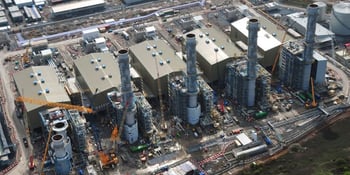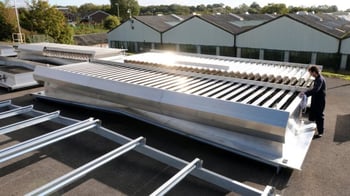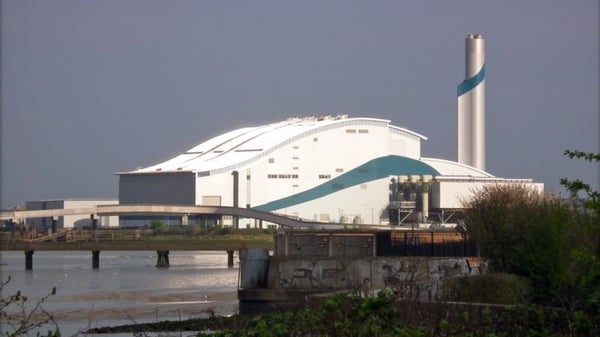 To achieve the right temperature, humidity and air quality in a power plant whilst keeping costs low, you must understand the differences between natural ventilation systems and mechanical ventilation systems.
To achieve the right temperature, humidity and air quality in a power plant whilst keeping costs low, you must understand the differences between natural ventilation systems and mechanical ventilation systems.
In the majority of power plant cases, natural ventilation is the ideal solution. In this blog post, we will explain why this is the case, and highlight cases where mechanical ventilation would be recommended.
Selecting the best ventilation system for a building
As a designer, it is vital to select the right type of ventilation system for the building. This will ensure that the maximum temperature limit of the plant is not exceeded. Achieving this will enable the plant to operate efficiently whilst providing comfortable conditions for workers.
Computational Fluid dynamics analysis, also known as CFD analysis, is an excellent tool that can be used to determine the best ventilation strategies for different building types.
CFD analysis plays an important role in regulating the indoor air parameters to predict ventilation performance in buildings. These predictions can provide valuable information about the flows and transfer of energy within the building in different situations.
These predictions can be made before the construction of the building, to ensure that the building is designed to maintain a thermally comfortable environment.
Factors that affect the indoor climate of a power plant include:
- Excessive heat
- Excessive condensation
- Contaminants released by the power generation process
Natural ventilation and why it is the best solution for most power plants
 Power plants are generally tall buildings. This creates a good stack effect (i.e. "stack ventilation") that makes the movement of air between different levels easy.
Power plants are generally tall buildings. This creates a good stack effect (i.e. "stack ventilation") that makes the movement of air between different levels easy.
Furthermore, internal heat gains are very high compared to external ones. This results in a good temperature gradient throughout the building.
Also, natural ventilation will not only lower the internal temperature very efficiently but also reduce humidity and extract contaminants. This aids in creating a comfortable working environment with good air quality.
Finally, natural ventilation is a cost-effective solution. The running costs are negligible. There’s no energy consumption, it requires minimum maintenance, it is not liable to breakdown and it is self-compensating, meaning the hotter the air, the more air can be moved and the more efficient the system is.
Aside from cost-effectiveness and efficiency, natural systems use less energy than mechanical systems. This means that it has a lower environmental impact.
In a previous blog post, we quantified the environmental impact of natural ventilation systems vs mechanical ventilation systems.
Factors you should consider with natural ventilation
Here are 3 factors to consider with natural ventilation systems for power generation plants:
- Positioning your temperature sensors. The system will operate using temperature readings from your sensors. They mustn’t be positioned next to areas that will artificially affect the readings. For example, these can be areas with high heat gains or that have excessive draughts.
- Positioning your inlet ventilators. In some cases, a low level inlet ventilation is required to control internal temperatures when the outside temperature is below 0ºC. If this is the case, you should ensure that inlet equipment is not positioned next to areas that will be affected by sub-zero temperatures.
- Limit low level inlet velocity to 1.5m/s. If the inlet velocity exceeds 2m/s, you could have issues with noise and vibration. High level extract velocity is harder to control; even though some roof ventilators can cope with a higher velocity, you should try to limit it to 3.5m/s.
An example of natural ventilation being used in a powerplant
Belvedere Riverside Resource Recovery, London
The Riverside Resource Recovery Facility (RRR) is an energy from waste (EfW) plant located in Belvedere, UK.
Colt provided a ventilation and smoke control system for the EfW plant back in 2011. Colt installed 1500m of roof-mounted Labyrinth natural ventilators. These ensure a safer environment within the building in the event of a fire and reduce the temperature. This helps to create a more comfortable working environment within the building.

When natural ventilation is not the right solution for a power plant
Here are four scenarios where natural ventilation is not the ideal solution for power generation plants:
- When the building is not tall enough - In this scenario, the lack of building height means that the stack effect cannot be achieved.
- Where there is not enough internal gain - In this scenario, there isn’t sufficient internal gain to generate a temperature gradient.
- Lack of low-level space - In this scenario, there isn’t enough space at low levels to provide the required inlet area. With natural ventilation, the pressure differential across the inlet or extract system must not be too high, or it won’t work effectively.
- Where there is no direct access to outside - In this scenario, the building is entirely or partially enclosed within the main structure, so that there is no direct access to the outside. Therefore, it is impossible to provide openings for natural ventilation. This is sometimes the case for turbine halls.
Factors you should consider with mechanical ventilation
The goal with all ventilation system solutions is to achieve efficient operation of the plant whilst providing comfortable working conditions for staff. This involves guaranteeing the plant’s maximum temperature limits are never exceeded. With this in mind, when designing a mechanical ventilation system, these factors should be taken into consideration.
- The required amount of air, inlet and extract and how to get it in and out; for example, whether it will need to be ducted.
- The system you select must ensure good distribution.
- Noise pollution: the system shouldn’t add to the noise levels within the building or in the surrounding area.
- Natural or mechanical inlet: to use a natural inlet, the pressure drop must not be too high or it will negatively impact the effectiveness of the overall system.
- What the running costs will be. Mechanical ventilation has a much higher energy consumption (often referred to as ‘parasitic load’ compared with a natural solution.
- Will the system also be used for smoke ventilation. If so, you will need to provide equipment with the correct fire / temperature rating.
Summary
Power generation facilities such as Energy from Waste (Efw), Biomass, CHP, and Anaerobic Digestion plants are ideally suited for natural ventilation systems. These aid in the dissipation of heat, dilution of fumes, and clearance of smoke in the event of a fire.
Designing a natural ventilation system can be a complicated process. Therefore, we recommend that you take advice from a natural ventilation specialist. They should be able to offer free design (make sure it includes a guarantee of performance), CFD modelling, product selection/sizing/integration, and controls.
You can find further information in our other articles on ventilation relating to power generation facilities, or contact us.
If your building is too hot or too cold, if your process gives off fume or moisture, if your product requires specific conditions during its manufacture or storage, or if noise is a concern, then we may be able to help you.
We can survey your building using a range of techniques and equipment to identify your problem. Once established, we can then recommend a solution based on proven design work.
Request a no obligation consultation with one of our technical experts
 Paul Langford is an Engineering Director with experience in product development, manufacturing and testing for HVAC, solar shading, louvre systems and smoke control applications.
Paul Langford is an Engineering Director with experience in product development, manufacturing and testing for HVAC, solar shading, louvre systems and smoke control applications.

